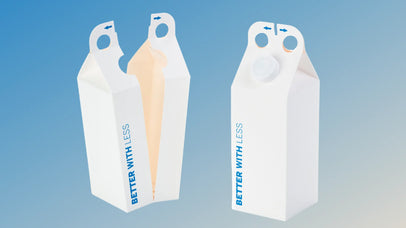Packaging 101: The Complete Guide
- Packaging 101
- Types of Packaging
- Aseptic Packaging
- Blister Packaging
- Biodegradable Packaging
- Bulk Packaging
- Carbon Neutral Packaging
- Circular Packaging
- Clamshell Packaging
- Compostable Packaging
- Cornstarch Packaging
- Corrugated Packaging
- Discreet Packaging
- Ecommerce Packaging
- Flexible Packaging
- Frustration Free Packaging
- Retail Packaging
- Secondary Packaging
- Smart Packaging
- Sustainable Packaging
- What is a PR Package?
- What is a Poly Mailer?
- Packaging Design Ideas
- AI Packaging Design
- Bakery Packaging Ideas
- Bath Bomb Packaging Ideas
- Bath Salt Packaging Ideas
- Body Butter Packaging Ideas
- Body Oil Packaging Ideas
- Body Scrub Packaging Ideas
- Brownie Packaging Ideas
- Cake Packaging Ideas
- Cake Pop Packaging Ideas
- Candle Packaging Ideas
- Candy Packaging Ideas
- Canva Packaging Design
- Chocolate Packaging Ideas
- Cinnamon Roll Packaging Ideas
- Clothing Packaging Ideas
- Coaster Packaging Ideas
- Coffee Bag Design Ideas
- Cookie Packaging Ideas
- Cosmetics Packaging Design
- Cotton Candy Packaging Ideas
- Cupcake Packaging Ideas
- DIY Packaging Ideas
- Dog Treat Packaging Ideas
- Food Packaging Ideas
- Empanada Packaging Ideas
- Etsy Packaging Ideas
- French Fries Packaging Ideas
- Frozen Food Packaging Ideas
- Hair Extension Packaging Ideas
- Handbag Packaging Ideas
- Jewelry Packaging Ideas
- Keychain Packaging Ideas
- Lash Packaging Ideas
- Lip Gloss Packaging Ideas
- Macaron Packaging Ideas
- Minimalist Packaging Ideas
- Mug Packaging Ideas
- New Employee Welcome Kit Ideas
- Packaging Colors
- Packaging Inserts Ideas
- Packaging Logo Design
- Packaging Typography
- Perfume Box Design Ideas
- Pizza Box Design Ideas
- Popcorn Packaging Ideas
- Scarf Packaging Ideas
- Skincare Packaging Design Ideas
- Soap Packaging Ideas
- Sock Packaging Ideas
- Sticker Packaging Ideas
- Sunglass Packaging Ideas
- Sustainable Packaging Ideas
- Tea Packaging Ideas
- Wax Melt Packaging Ideas
- Weed Packaging Ideas
- T-Shirt Packaging Ideas
- Wine Packaging Design Ideas
- What is a Packaging Engineer?
- Types of Packaging Materials
- Chipboard vs Cardboard
- Compostable Packaging Materials
- Alternatives to Plastic Packaging
- Edible Packaging Materials
- Food Packaging Materials
- Are Poly Mailers Recyclable?
- How to Recycle Cardboard Boxes
- How to Recycle Packaging Materials
- Medical Device Packaging Materials
- Mono Material Packaging
- Pharmaceutical Packaging Materials
- Plastic Food Packaging
- Protective Packaging Materials
- Reusing Packaging Materials
- Types of Packaging Foam
- Void Fill Packaging
- What is Chipboard?
- What is Kraft Paper?
- Offset vs Digital Printing
- RGB vs CMYK Printing
- Screen Printing vs Digital Printing
- Screen Printing vs Sublimation
- What is a Dieline in Packaging?
- What is Die Cutting?
- What is Digital Printing?
- What is Flexographic Printing?
- What is Glassine Paper?
- What is Offset Printing?
- What is Spot UV Printing?
- Why is 300 DPI Good for Printing?
- How to Estimate Shipping Costs
- How to Pack Glass for Shipping
- How to Mail a Bubble Mailer
- How to Make a Shipping Label
- How To Measure Box Dimensions and Sizes
- How to Ship Alcohol
- How to Ship Artwork
- How to Ship Books
- How to Ship a Cake
- How to Ship Candles
- How to Ship Chocolate
- How to Ship Clothes
- How to Ship Cookies
- How to Ship Food
- How to Ship a Hat
- How to Ship Jewelry
- How to Ship a Laptop
- How to Ship Perfume
- How to Ship a PC
- How to Ship Perishable Food
- How to Ship Plants
- How to Ship Shoes
- How to Ship Vinyl Records
- Packaging Symbols
- Shipping Large Items
- What is a Delivery Exception?
- What is Shipping Insurance?

Meet Kyla Moore, the dynamic project coordinator at Arka, who is driven by her passion for sustainable packaging. She is dedicated to assisting businesses.
Key Advantages and Challenges of Circular Packaging
The advantages of circular packaging will change your approach towards this sustainable packaging solution. Yet, you also must be aware of all the challenges that may occur when switching to a new type of packaging. That’s why we would like to analyze both!
The Benefits of Circular Packaging
We will primarily start with the positive side of circular packaging. We are sure the benefits will cause the simple on your face!
• Sustainable Resource Management: it is about time that humans do whatever it takes to protect nature from being destroyed or overused. Circular packaging will ensure smooth, sustainable resource management thanks to the principles it promotes.
• Waste Production: as we said at the beginning of this article, the entire planet Earth is dealing with billions of tons of waste every year. That negatively impacts the entire planet, causing climate changes, air pollution, etc. The circular packaging will significantly reduce the waste your company usually produces.

• Lower Carbon Footprint: reducing greenhouse gases that we generate by our actions can also be reduced by switching to circular packaging. Only in the United States, the average person generates 16 tons of greenhouse gases per year (one of the highest in the world). Fortunately, businesses can significantly decrease that by using this strategy. Plus, the taxes will be much lower if the carbon footprint decreases.
• Better Reputation: an average modern consumer requires sustainability practices! All things you can do with circular packaging will positively influence the entire planet Earth. People will appreciate your concerns and the effort you invest. Because of that, your reputation will slowly start to grow. Many people will pick your brand just because of the eco-friendly actions you are supporting!
Challenges and Obstacles in Circular Packaging Adoption
Challenges should not ruin the first impression you have gotten after reading the list of benefits. These are just hints and things entrepreneurs should pay attention to when making the final decision. You may have to face three challenges:
• Consumer Awareness: many consumers (part of your target audience) will not understand the importance and benefits of circular packaging. You will have to invest time, money, and effort to educate people on what circular packaging is, how they should use it, and so on.
• Infrastructure and Logistics: circular packaging requires a completely new way of business functioning. You will need to get a new infrastructure for these packages and improve logistics. Get familiar with this type of packaging and educate your employees before officially making the change.
• Policy and Regulations: working with circular packaging comes with different law regulations, and policies that the businesses must respect. Every package that leaves your warehouse must be properly controlled. The smallest mistakes can bring huge penalties, negatively impacting the company’s profit and overall functioning.

Understanding The Circular Economy: 3 Principles
You won’t manage to understand circular packaging to the fullest if you are not familiar with the principles of the circular economy. The circular economy has a specific way of functioning which looks like this: raw materials > production > use > recycle > use > repeat. As you see, it differs greatly from linear and recycling economies that were popular for many years. To ensure these processes go smoothly, experts have determined 3 principles of circular economy.
They are:
1. Reduce
2. Preserve
3. Regenerate
• Reduce: Ensure Designs that Eliminate Waste and Pollution: one of the ideas that the circular economy supports is the complete elimination of waste and air pollution. These two problems are defined as a consequence of the bad designs. It supports the idea of using the most modern techniques that are not harmful to the surroundings. As an entrepreneur, you should use only packages that are made of eco-friendly materials.
• Preserve: Keep the Materials in the Economy: preserving finite resources and keeping them in the economy is the second principle. In other words, this economy supports the idea u reusing the same materials for as long as possible. Regarding packaging, they should be made of materials that can be remanufactured, repaired, and reused. Yet, that’s not all! It is not a point to just use all the materials as long as that is possible. The second principle also aims to reduce the waste that would end up in landfills. Reusing the existing materials is one of the strategies to reach that goal!

• Regenerate: Do Good for the environment: the linear economy aims to eliminate all the factors that negatively impact the environment. Yet, the circular economy wants to go an even step further. The supporters of this type of economy want to do something good for the environment. That is the reason why restoring nature's cycles and systems is one of the goals they have. The strategy they use is taking a cyclical approach. You should try to develop systems that will support, improve and protect our ecosystem. One of the things you can do is give back all the resources you use to nature (not just turn them into waste).
Strategies for Effective Circular Packaging
Switching to circular packaging is not easy; it is a process that will last for many years. Yet, things can be simplified if we use the right strategies to reach our goals. Here are some of them that can ensure effective circular packaging
• Collaboration between industries: the entire business world has to collaborate closely on all circular economy processes
• Consumer education and engagement: the changes won’t mean anything if consumers are not properly educated. Their role in the circular economic system is crucial. It will be essential to, together with other businesses, educate consumers and explain all benefits to them.
• Investment in research and innovation: business owners should not hesitate to invest in finding the best circular packaging solutions. Those investments may not bring a direct profit. Yet, they will bring all the mentioned benefits on a long-term basis.
Circular Packaging in Different Industries
There is no universal way to use circular packaging. How the entire process will look depend on the industry you are involved in. That’s why we would like to analyze this type of packaging in four different industries. Let’s go!
Food and Beverage
It is not a secret that businesses involved in the food and beverage industry produce a lot of waste yearly. That can be stopped by accepting the circular economy principles and switching to circular packaging. That way, the waste would be minimized, and sustainability will become a priority. Some of the circular packaging examples for food and beverage industries are compostable snack packaging, refillable beverage containers, and so on. At Arka, we create sustainable and eco-friendly custom food boxes that help increase customer trust and satisfaction.

Personal Care and Cosmetics
Businesses involved in personal care and cosmetics have a more challenging task. Despite supporting sustainability, they must create aesthetically pleasing packages. All the packaging types, like jars and bottles, must be made of biodegradable or recyclable materials. Also, a good idea would be to give back the empty containers. They can later be either recycled or refilled. We also offer premium custom cosmetic boxes that are sustainable and ensure the safety of your products!

Electronics and Technology
So-called e-waste also has a negative impact on the environment. Fortunately, circular packaging can significantly reduce that impact! Businesses should invest in research to discover the designs that ensure smooth repair or recycling of the electronic devices they sell. Also, they can use modular packages for all sorts of components to reach their goals.

Credits: Pentagram, Dieline
Fashion and Apparel
Reimagining how all accessories are packed and shipped is one of the goals of fashion businesses. Brands that respect circular economy principles use biodegradable garment bags to reach their goals and explore reusable, biodegradable packaging solutions. Yet, they also invest much time and energy in promoting a circular approach. That’s why you can find brands that encourage their consumers to recycle old clothing items or donate them to someone else.

Credits: Supple Studio, Dieline
Circular Packaging Success Stories
Everything we just said will probably convince you to switch to circular packaging. Yet, real-life circular packaging examples may leave an even stronger impression. There are 3 success stories of very popular brands from different industries we would like to talk about.
Loop: A Groundbreaking Reusable Packaging Platform
Loop’s circular packaging initiative is among the best success stories we have heard about. When people order their products online, they get them in durable and customized containers. Yet, when those containers are used, people from Loop come to collect, clean, and refill them. That way, they managed to reduce the amount of single-use packaging waste. Of course, this innovation requires some larger investments. Yet, their initiative significantly impacted the awareness of consumers for circular packaging.

Credits: Tesco
Ecover: Championing Plant-Based Packaging
Ecover is one of the most successful brands for sustainable personal care products. However, it is also known as a brand strongly supporting biodegradable and plant-based packaging materials. Some of the packaging materials they use are recycled plastic and sugarcane. They have been an inspiration for many companies in different industries.

Credits: Kari Embree
Nestle’s Loop-Certified Ice Cream Containers
Loop and Nestle established a collaboration a few years ago. They agreed on using reusable ice cream containers. All those containers were made of stainless steel. Yet, the more important thing is the way they were designed. Employees of Nestle could easily collect, clean, and refill them. That allowed all Nestle fans to enjoy the treats while participating in the circular economy. Collaborations like that should be more often in today’s business world!

Credits: Loop
Final Thoughts
At Arka, we know that circular packaging can really be one of the solutions to the global problems we are facing. We hope companies within different industries will make deals like Nestle and Loop did. Collaboration between entrepreneurs in spreading the importance of circular packaging is the only way to educate consumers and convince entrepreneurs to change their packaging strategies.
FAQs on Circular Packaging
Is circular packaging economically viable?
Yes, circular packaging is economically viable. Although you will need to make the initial investments in logistics and infrastructure, it can benefit your business in the long run. It allows you to reduce waste management costs, ensure better customer engagement and improve brand loyalty.
What role does legislation play in promoting circular packaging?
Legislation plays a crucial role in circular packaging promotion! You must follow all government regulations and policies when adopting circular packaging for your business. Some of the ways of its contribution are EPR, packaging and labeling requirements, economic incentives, and so on.

